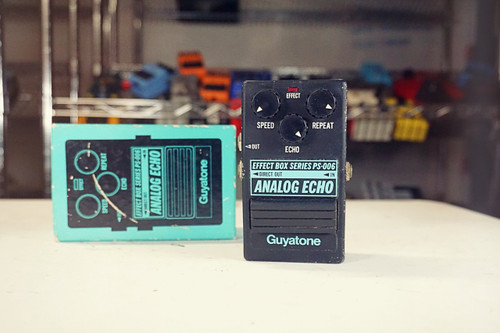Roland RE-201 Space Echo Tape Delay / Reverb
Made in Japan in the 1970s. This is not your average as-is tape delay unit. This has been fully serviced by a reputable shop in Japan. Comes with service manual from shop and a stepdown transformer for use with 120v.
From Roland:
Back in the mid-seventies, the RE-201 Space Echo unleashed a sound that came straight from outer space. This is its story…
Contributed by Roland UK Team By Jim Bybee Over the years, Roland has created a significant number of products that have gone on to become legendary. One of the earliest examples is the Roland RE-201 Space Echo, a combination tape echo and reverb introduced in 1974. While Roland didn’t invent the tape echo itself, they took a fragile and often unreliable technology and turned it into something robust and roadworthy and the RE-201 immediately became the touring and recording studio standard in portable tape echo.
Echoing through history
As anyone who sings or plays an instrument knows, the acoustic space you perform in has a huge impact on the sound. If you perform in a small, dry-sounding space—such as a heavily carpeted room—the sound is small and uninspiring. But if you take that same performance to a large space with hard surfaces, the sound becomes bigger, with the natural reverberation of the room making your performance feel more alive. Since the dawn of sound amplification and recording, musicians and audio engineers sought a way to add the natural ambience of a large acoustic space to a sound in a controlled manner. This led first to natural echo chambers, where a sound was re-amplified into a large acoustic space and captured with a microphone. Later, electronic methods were developed to create artificial reverberation by amplifying sound waves through metal plates or springs. The spring reverb, first developed for use in home organs, continues to be a staple in guitar amplification. Shortly after World War II, magnetic tape technology became the standard for audio recording. Audio engineers realised they could also use their reel-to-reel tape recorders to create an echo of a sound for a unique type of artificial ambience. The effect quickly became popular, particularly when a short echo was combined with reverb. This type of “slapback” echo was an essential sound component on early rock and roll recordings, and is still popular today
- reverb_sync:
- force
- reverb_year:
- 1975
- reverb_offers:
- on
- reverb_model:
- RE-201 Space Echo Tape Delay / Reverb
- reverb_condition:
- Very Good
- reverb_shipping_profile:
- small pedals
- reverb_seller_cost:
- 705.39
- reverb_finish:
- Black



















